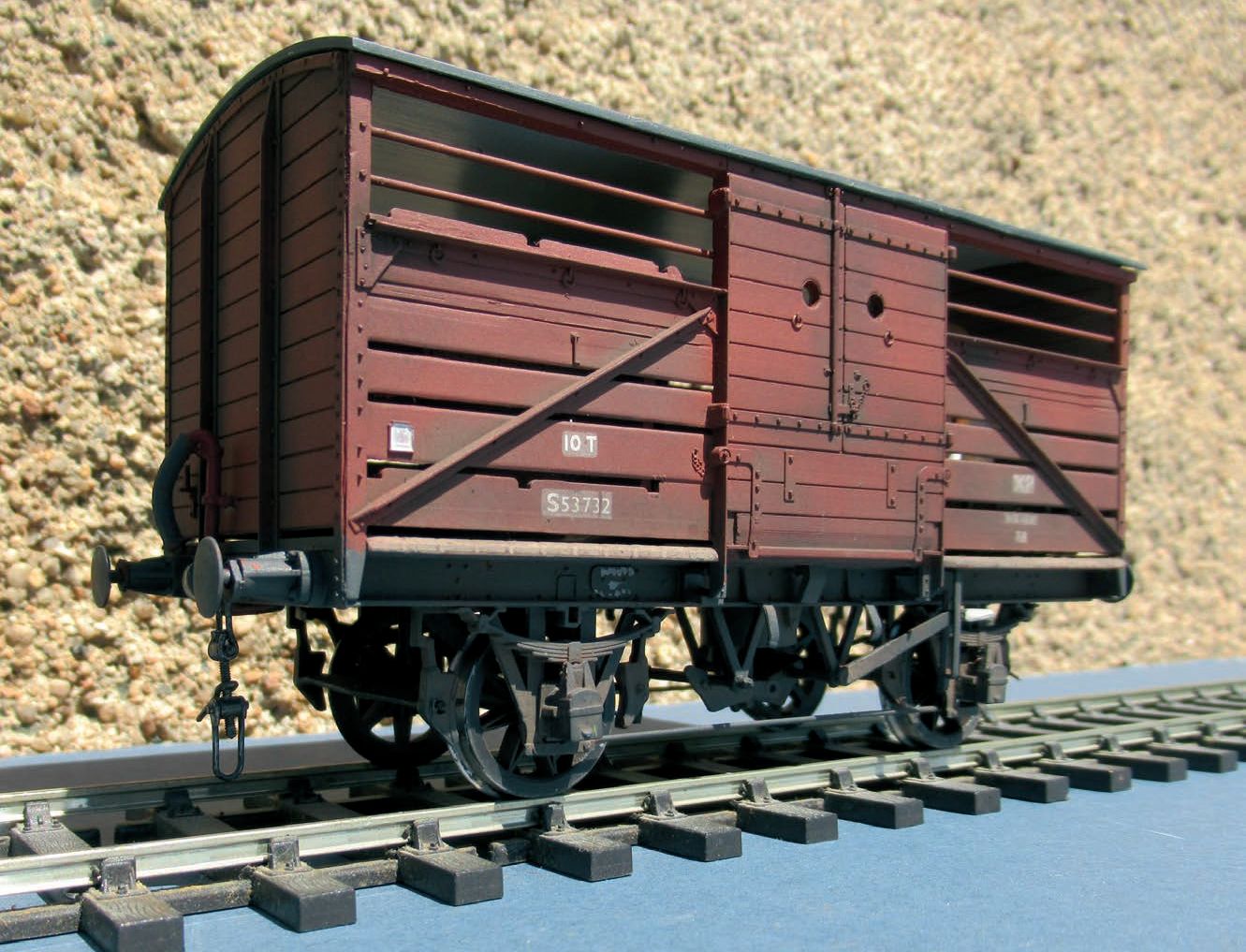SR cattle wagon
Chris Gwilliam locks horns with an SR cattle wagon
Photos by the author unless otherwise stated
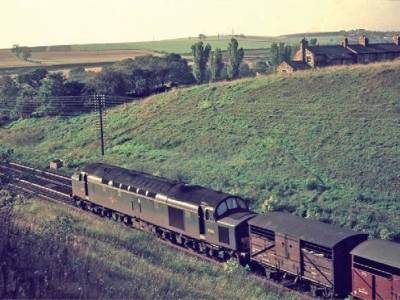 A similar SR cattle wagon, to D1530, which Bulleid evolved from the D1529 by adding corner brake V’s and plywood ends. The body sides are the same as the kit. It would make a good conversion project. English Electric D350 is heading south through Redhills Cutting south of Durham on 17.10.1962.
A similar SR cattle wagon, to D1530, which Bulleid evolved from the D1529 by adding corner brake V’s and plywood ends. The body sides are the same as the kit. It would make a good conversion project. English Electric D350 is heading south through Redhills Cutting south of Durham on 17.10.1962.
 A Birthday present from two of my children dropped into my mailbox. A Parkside (now PECO) kit for a Southern D1529 cattle wagon (built 1930-39), some of which survived until the end of the 1950s, the period I model. Early examples of this diagram have a gap between the top plank and the L-iron framing, later examples do not. The kit conforms to the later type, as shown in plate 101 of An Illustrated History of SR Wagons vol 4 (Bixley et al. OPC) from which I worked. A quick inspection showed that the plastic mouldings were up to the usual high standard one would expect from this range.
A Birthday present from two of my children dropped into my mailbox. A Parkside (now PECO) kit for a Southern D1529 cattle wagon (built 1930-39), some of which survived until the end of the 1950s, the period I model. Early examples of this diagram have a gap between the top plank and the L-iron framing, later examples do not. The kit conforms to the later type, as shown in plate 101 of An Illustrated History of SR Wagons vol 4 (Bixley et al. OPC) from which I worked. A quick inspection showed that the plastic mouldings were up to the usual high standard one would expect from this range.
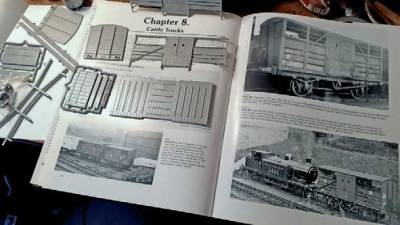 Checking the parts for conformity to prototype. The wagon on the lower right was used as the basis for the model. The book is 'An Illustrated History of Southern Wagons Vol 4' by G Bixley et al, OPC, 2002
Checking the parts for conformity to prototype. The wagon on the lower right was used as the basis for the model. The book is 'An Illustrated History of Southern Wagons Vol 4' by G Bixley et al, OPC, 2002
Correct split spoke wheels are included, as are transfers for SR and BR periods, and the box is big enough to hold the finished model. At £34.50 I regard this kit as excellent value. The instructions and drawings are comprehensive, but experience with previous models from this stable (I was tempted to say byre) led me to make some significant changes to the order of construction.
The very first step was to assemble the buffers on the headstocks before gluing sides, floor and ends together, because access to the rear of the headstock is so much easier with the ends separate. I also added the 0.7mm straight
brass wire to the voids in the upper sides before making up the basic five-sided box.
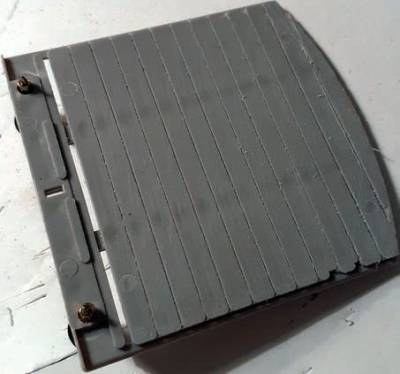 Easier to fit the buffers before the ends are attached to the floor and sides.
Easier to fit the buffers before the ends are attached to the floor and sides.
There are indents in the ends for the wires, but instead I filed small notches in the corner pillars of the sides to get a snug fit for the wires. The kit was a bit mean with the amount of wire provided and I ended up having to use some additional straight steel rod from my stock for the tie bars between the W-irons; and some 0.5mm wire for some of the brake assembly.
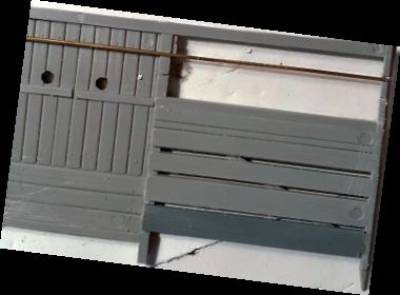 Small slots cut in the end posts to seat the wire.
Small slots cut in the end posts to seat the wire.
Then I did as I was told and used Mekpak to join sides, ends and floor, but in retrospect it would have been better to have left off one end until after the solebars were added, as this would have avoided having to bow the solebars to spring them into position, which is quite tricky. This tip works for most of the kits in the range. The solebars have moulding pips on the rear, which need removing or the W-irons and V-hangers will not fit snugly against their rears.
 Body ready for fitting the solebars, but it would been easier to have left off one end until after the solebars were in position.
Body ready for fitting the solebars, but it would been easier to have left off one end until after the solebars were in position.
The underframe timbering (referred to as the ‘sub chassis’ in the instructions) needs fitting at this stage – i.e.
before the wheelsets are in place, not after as suggested, which would be much fiddlier.
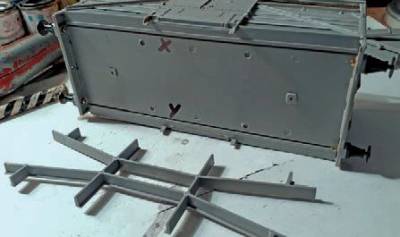 The instructions advise marking the floor X and Y to differentiate between the solebars. One has two V-hangers, the other only one.
The instructions advise marking the floor X and Y to differentiate between the solebars. One has two V-hangers, the other only one.
The axle boxes are designed to be a sliding fit in the W irons, which gives an element of compensation, but I now
add small phosphor bronze coil springs to all my Parkside kits. These were originally for springing buffers in
Mallard/Blacksmith coaches. Slaters can provide something similar, I’m sure. Each spring needs cutting in two to give about five coils. A piece of plastic needs to be removed from the upper rear of the axle boxes, to make space for the springs, and a spigot from 0.9mm wire will be needed to retain each spring in position. I tried drilling a 1mm hole into the top rear of the axle boxes to add spigots to one pair; and drilling a hole on the underside of the plastic leaf springs to take the spigot on the second pair. I conclude that the second method is better.
 The components for the axle box suspension. The W-irons on the left have spigots on the underside of the plastic leaf springs to retain a small coil spring. The pair on the right have the spigot on top of the axle box. The left-hand version is more effective. A piece of material has been cut off the top rear of each axle box to make room for a spring.
The components for the axle box suspension. The W-irons on the left have spigots on the underside of the plastic leaf springs to retain a small coil spring. The pair on the right have the spigot on top of the axle box. The left-hand version is more effective. A piece of material has been cut off the top rear of each axle box to make room for a spring.
 Coil springs glued to the underside of the plastic leaf springs.
Coil springs glued to the underside of the plastic leaf springs.
When fixing the springs, take great care not to get any superglue into the sliding portion of the assembly. Take equal care not to clog the area with paint at a later stage. All four wheels should be level and the vehicle should have about 2mm of vertical bounce. This will make for perfect running, even on indifferent track-work. I found that there was a little end-float on the axles once the wheelsets were in place, cured by a washer on each axle end. With the wheels in place and the wagon on its side, I laid a heavy pair of pliers on top of the axleboxes while the Mek was curing, as the W irons have a tendency to splay outwards while the plastic is still soft.
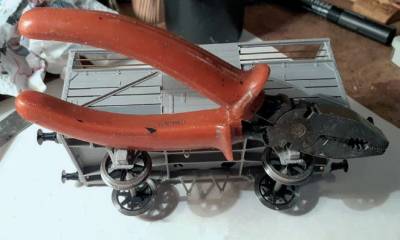 A heavy pair of pliers to weigh down the axle boxes so the solebars don’t splay out while the glue dries
A heavy pair of pliers to weigh down the axle boxes so the solebars don’t splay out while the glue dries
The brake gear on Southern fitted wagons is idiosyncratic and complex. It pays to do some research as it may be that the drawings in the instructions are not entirely accurate. They imply that, of the four yokes, two should be angled towards the underside of the floor and two towards the track, but the drawing in SR Wagons vol 4 shows all four yokes angle towards the underside of the floor. I think the latter is more likely so that’s the route I chose, but I may be wrong. Photos of the prototype are not common, and none I could find showed up the brakes clearly enough to prove the point.
The small parts numbered 26, 28 and 29 which link the braking system to the floor are best fitted before the yokes are in place. White plastic rod is provided for the cross-rods between the V-hangers, but I substituted 1.2mm iron wire for extra strength. I was in some confusion about these cross-rods, got the layout wrong and had to disassemble and re-glue. On these wagons there are two V-hangers on one solebar, with the vacuum cylinder on that side, one vee on the far side (off-set to the right of the centre as you are looking at the wagon from that side and the right way up.) This is the side which has the notches for the long/medium/short internal dividing panel on the right – thinking three-dimensionally may do your head in, (so check photos!). The fourth V-hanger is attached to one of the longitudinal central ribs under the floor with a rod attached to the hanger, which services the brake lever on the side without the vacuum cylinder.
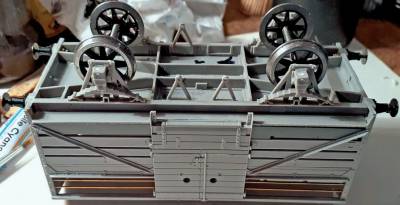 Three of the V-hangers in place; the fourth will be attached to a longitudinal floor rib, not the rear of the solebar
Three of the V-hangers in place; the fourth will be attached to a longitudinal floor rib, not the rear of the solebar
I found it difficult to fit the two cranks which attach the vacuum cylinder piston to the cross rods. Squeezing the end of the piston in a pair of smooth-jawed pliers to produce a flat surface helped with fixing. Drilling small holes at the extremities of the cranks also helped to solve the problem. The brake shoes need 2mm holes drilling to accept the spigots on the end of the yokes. I cut short the pull rods between the yokes and the cross shafts, to avoid trapping the wheels in position.
Contrary to instructions, I left fitting the brake levers and guide until the very end, as the plastic parts are fragile and prone to handling damage. The same applied to the tie bars between the keeper plates (and once again take great care not to get glue into the moving axle boxes). As there was insufficient brass wire, I used straight steel wire sufficiently long that it covered the whole length of the rear of the keeper plates, not just the inner corners, and attached it with 5-minute epoxy. The remaining small body parts (lamp irons etc) are also added near the end of the build sequence. I found the door springs did not fit the recess in the solebars until they had been trimmed. I damaged two and substituted brass strip. The door stops also need a little trim. There was one tiny packing error: the kit had non-identical whitemetal vacuum hoses, so I jettisoned the shorter one and found a replacement in my spares box which was a better match for the one which was the correct height.
Couplings provided are 3-links. Put them in your spares box and substitute screw couplings as 3-links are wrong for vac-fitted vehicles. I used Premier couplings which are so easy because they come ready assembled.
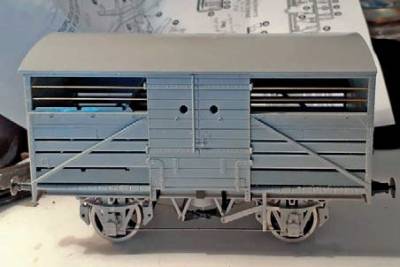 The completed model ready for painting. The tie bars between the keeper plates are steel rod, as there was not enough brass wire in the kit.
The completed model ready for painting. The tie bars between the keeper plates are steel rod, as there was not enough brass wire in the kit.
Painting was easy enough. Matt black rattle can for the brake gear and underframe (with the axle boxes masked off), brushed off-black enamel (equal parts Humbrol Coal Black and Desert Sand) very carefully applied around the axle boxes), body primed in red oxide, and then an airbrushed coat of Railmatch BR Bauxite – though this was so similar in tone to the undercoat I probably need not have bothered. Waterslide transfers went into position next.
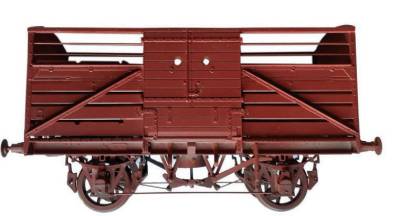 Topcoat from Railmatch BR Bauxite.
Topcoat from Railmatch BR Bauxite.
I placed them according to the photo I was working from, which differs slightly from the sketch in the instructions,
though no doubt there were variations in service. The shiny backing film was deadened with an airbrushed coat of Wickes interior matt varnish (the runny sort, not the gel), well thinned. The underside of the roof is matt white, the interior is brushed Desert Sand and the roof is airbrushed Humbrol 67 Tank Grey. The light weathering is just a
dusting of Greenscene powders applied with a soft brush.
 The wagon in ex-works condition. Even with a coat of satin varnish the transfer film is still just visible. Maybe HMRS Pressfix replacements would have been better than the waterslides provided.
The wagon in ex-works condition. Even with a coat of satin varnish the transfer film is still just visible. Maybe HMRS Pressfix replacements would have been better than the waterslides provided.
I ordered a pack of Woodland Scenics Hereford cows so the wagon could run loaded. The pack says ‘11 pieces’, which is four cows and three calves: the rest are tiny plastic cow-pats! This is an American product and is therefore 1:48 scale, not UK O gauge, so the beasts are a bit small. I jacked them up by about 6mm on a removable dummy floor of honeycomb packing card to make them a bit more visible, and the subterfuge is not obvious unless you peer very
closely indeed. The cows were SFTB (‘straight from the box’), an abbreviation my railway-savvy children use with contempt), so I may at some point weather the hindquarters with a brush-load of green slime.
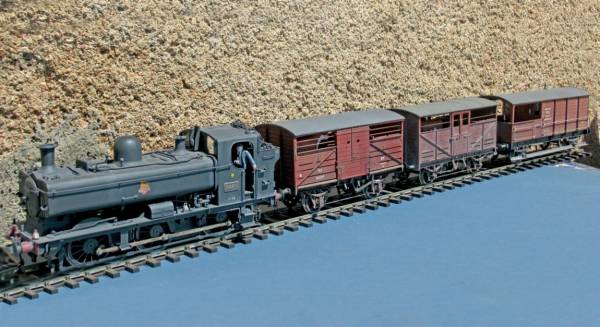 In service in a short train with a Slaters GWR W5 Mex and a Connoisseur fitted Toad.
In service in a short train with a Slaters GWR W5 Mex and a Connoisseur fitted Toad.
I was heifer so pleased with the result; this is a fine kit, and I’m moooved to order the Parkside LNER fitted cattle wagon to add to the herd, sorry – rake. Forgive the terrible puns. I think I’ve milked them dry. I consider the kit would be suitable for a beginner who has some determination. If the brake gear is a bit too intimidating some of it could be omitted as it’s barely visible once the vehicle is on the track.
